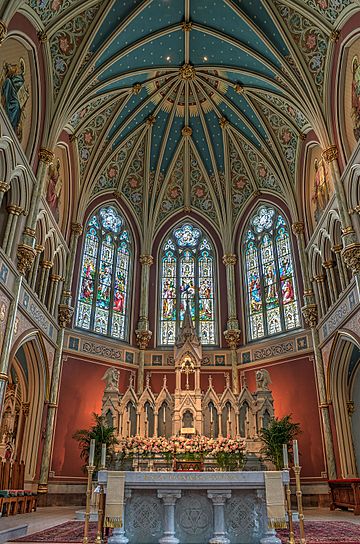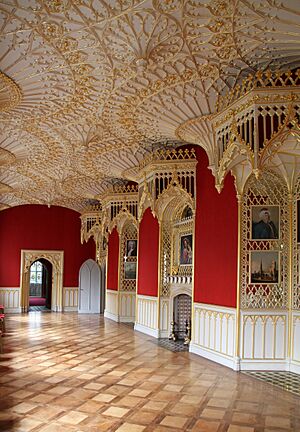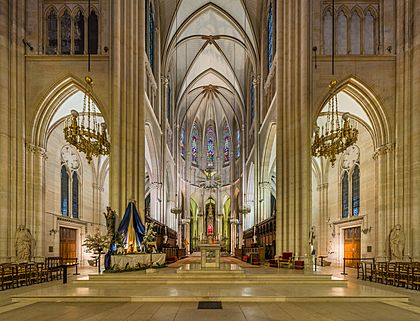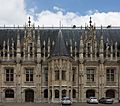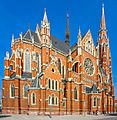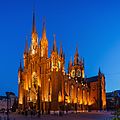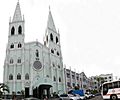Gothic Revival architecture facts for kids
Gothic Revival architecture is a style of building that looks like it came from the Middle Ages, but was actually built much later. This popular style started in England around the 1740s. It became very popular in the 1800s. People who loved this style wanted to bring back the look of old Gothic architecture.
The original Gothic style was built in Europe between about 1140 and 1550. Later, from the late 1700s through the 1900s, it became fashionable to build in the Gothic style again. Architects and their clients had many styles to choose from back then. They could also choose older Classical or Renaissance styles.
Since real medieval Gothic buildings look quite different from each other, architects often copied parts of them. They also changed the style to fit the needs of their own time. The "Gothic Revival" style was most often used for churches, cathedrals, universities, town halls, and sometimes houses.
Gothic Revival buildings have features that look like real Gothic buildings. They often have:
- Pointed arches around doors and windows
- Arched stone roofs called "vaults"
- Tall towers and sometimes spires on top of towers
- Many stone carvings around doors and fireplaces
- Colorful stained glass windows
Contents
Why Gothic Revival Became Popular
The Gothic Revival style became popular for several reasons. One reason was a growing interest in the past, especially the Middle Ages. People started to appreciate old buildings and history more.
Looking Back to Medieval Times
As factories and machines became common during the Industrial Revolution, some people didn't like how cities looked. They felt that medieval times were a "golden age" before all the factories. Architects like Augustus Pugin believed Gothic buildings showed strong Christian values. He felt these values were being lost in the new industrial world.
Politics and Style Choices
Building styles sometimes had political meanings. The "rational" Neoclassical style was linked to new ideas like republicanism and liberalism. This was seen in countries like the United States and France.
The more traditional Gothic Revival style became linked to monarchies and older ways of thinking. This is why important government buildings were built in this style. Examples include the Palace of Westminster in London (where the British Parliament meets). Other examples are the Parliament Buildings in Ottawa, Canada, and the Hungarian Parliament Building in Budapest.
Gothic Style in Books
The Gothic Revival in architecture also led to a new type of story called the Gothic novel. These stories were often spooky and set in old castles. One of the first was The Castle of Otranto (1764) by Horace Walpole. Later, poets like Alfred, Lord Tennyson wrote poems about medieval heroes like King Arthur.
How the Style Survived and Came Back
Gothic architecture didn't completely disappear after the 1500s. It continued in some places, especially in cathedrals that were still being built. It also stayed alive in universities like Oxford and Cambridge. Some churches in rural areas of Europe also kept using Gothic styles.
Early Examples in Britain
In Britain, some buildings from the 1600s still used Gothic elements. For example, St Columb's Cathedral in Derry, built in 1633, has a Perpendicular Gothic look. Later, famous architects like Christopher Wren even designed new parts of old Gothic buildings to match the original style. His Tom Tower at Christ Church, Oxford, built in 1681, was made to look Gothic on purpose.
Gothic in Europe
Even in other parts of Europe, where the Baroque style was popular, some architects used Gothic ideas. In France, churches like St-Eustache in Paris continued to use Gothic building plans. In Italy, the Basilica of San Petronio in Bologna, which started in 1390, had its Gothic vaults finished in the 1600s.
A unique example is the Pilgrimage Church of Saint John of Nepomuk in the Czech Republic. It was designed around 1720 by Jan Santini Aichel. This church mixes Baroque and Gothic styles in a very creative way.
Romantic Ideas and Gothic Revival
In the mid-1700s, a movement called Romanticism grew. People became more interested in the Middle Ages. They started to appreciate old Gothic churches, tombs, and stained glass. They liked the idea of old ruins and how time made buildings look "picturesque."
Horace Walpole's house, Strawberry Hill House in London, started in 1749, is a key example. It had "Gothick" details that were popular at the time. Soon, other architects started adding Gothic touches to their designs.
In Scotland, some of the earliest examples of the revived style appeared. Inveraray Castle, built from 1746, included towers and castle-like features. This showed the power of the local duke.
Defining Gothic Styles
As the Gothic Revival grew, people wanted to understand the different types of Gothic architecture. In 1817, Thomas Rickman wrote an important book. It helped name and describe the different Gothic styles found in English churches. He used terms like Norman, Early English, Decorated, and Perpendicular. This book became a guide for architects and students.
The most common use for Gothic Revival architecture was building churches. Many large Gothic cathedrals in the U.S. were built in this style. These include the Cathedral of St. John the Divine and St. Patrick's Cathedral in New York City. The Washington National Cathedral in Washington, D.C., is another huge example. In Canada, the Basilica of Our Lady Immaculate in Ontario is a major Gothic Revival church.
Gothic Revival architecture remained popular for a long time. Even after the late 1800s, it was still used for churches, schools, colleges, and universities. This later style was often called "Collegiate Gothic." It stayed popular in England, Canada, and the United States into the mid-1900s. The style only started to disappear when new materials like steel and glass became common. Also, the need to build tall buildings in cities meant architects looked for different styles.
Famous Gothic Revival Examples
- Strawberry Hill House in Twickenham, near London. This was one of the first houses designed in the Gothic Revival style.
- The Houses of Parliament in London.
- Sydney University in Australia.
- São Paulo Cathedral in Brazil.
- The campuses of Yale University and the University of Chicago in the USA.
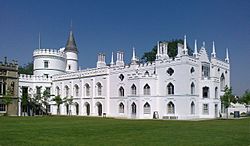
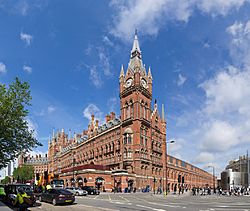
Images for kids
-
The study at Abbotsford, created for Sir Walter Scott. His novels made the Medieval period popular, which inspired the Gothic Revival.
-
Cologne Cathedral, finally completed in 1880, though construction began in 1248.
-
The Canadian Parliament Buildings from the Ottawa River, built between 1859 and 1876.
-
The Palace of Westminster (1840–1876), designed by Charles Barry & Augustus Pugin.
-
Venetian Gothic in Baku, Azerbaijan.
-
Exeter College, Oxford Chapel.
-
Carcassonne – Viollet-le-Duc restored the citadel from 1853.
-
Cast-iron Gothic tracery supports a bridge by Calvert Vaux, in Central Park, New York City.
-
Chhatrapati Shivaji Terminus in Mumbai, India.
-
Construction of Washington National Cathedral began in 1907 and was completed in 1990.
-
Liverpool Cathedral, whose construction ran from 1903 to 1978.
-
Schwerin Castle, Schwerin, Germany (1845–1857).
-
Schadau Castle, Thun, Switzerland (1846–1854).
-
Wrocław Główny railway station, Wrocław, Poland (1855–1857).
-
New Town Hall, Munich, Germany (1867–1905).
-
Town Hall, Manchester, England (1868–1877).
-
City Hall, Vienna, Austria (1872–1883).
-
Sturdza Palace, Iași County, Romania (1880-1904).
-
Hungarian Parliament Building, Budapest, Hungary (1885–1904).
-
Tower Bridge, London, England (1886–1894).
-
The Neo-Manueline (Portuguese Late Gothic) Rossio Station, Lisbon, Portugal (1891).
-
Co-cathedral, Osijek, Croatia (1898).
-
Cathedral of the Immaculate Conception, Moscow, Russia (1901–1911), an example of Brick Gothic revival.
-
Basilica of Our Lady Immaculate, Guelph, Ontario, Canada.
-
Rockefeller College, Princeton, USA.
-
St. Patrick's Cathedral, New York, USA.
-
Centre Block of the Canadian Parliament Buildings, Ottawa, Ontario.
-
Basilica of Our Lady of Luján, Buenos Aires Province, Argentina.
-
The São Paulo Metropolitan Cathedral, São Paulo, Brazil.
-
Basilica del Salvador, in Santiago, Chile.
-
The Las Lajas Sanctuary in southern Colombia.
-
Basílica del Voto Nacional, Quito, Ecuador.
-
St Paul's Cathedral, Melbourne, Australia.
-
St Patrick's Cathedral, Melbourne, Australia.
-
Christchurch Cathedral, Christchurch, New Zealand.
-
Otago Boys High School, Otago, New Zealand.
-
Church of the Saviour, Baku, Azerbaijan.
-
Basilica of the Sacred Heart of Jesus, Pondicherry, India.
-
Basílica Menor de San Sebastián, Manila, Philippines.
-
Sacred Heart Cathedral, Guangzhou, China.
See also
 In Spanish: Arquitectura neogótica para niños
In Spanish: Arquitectura neogótica para niños


